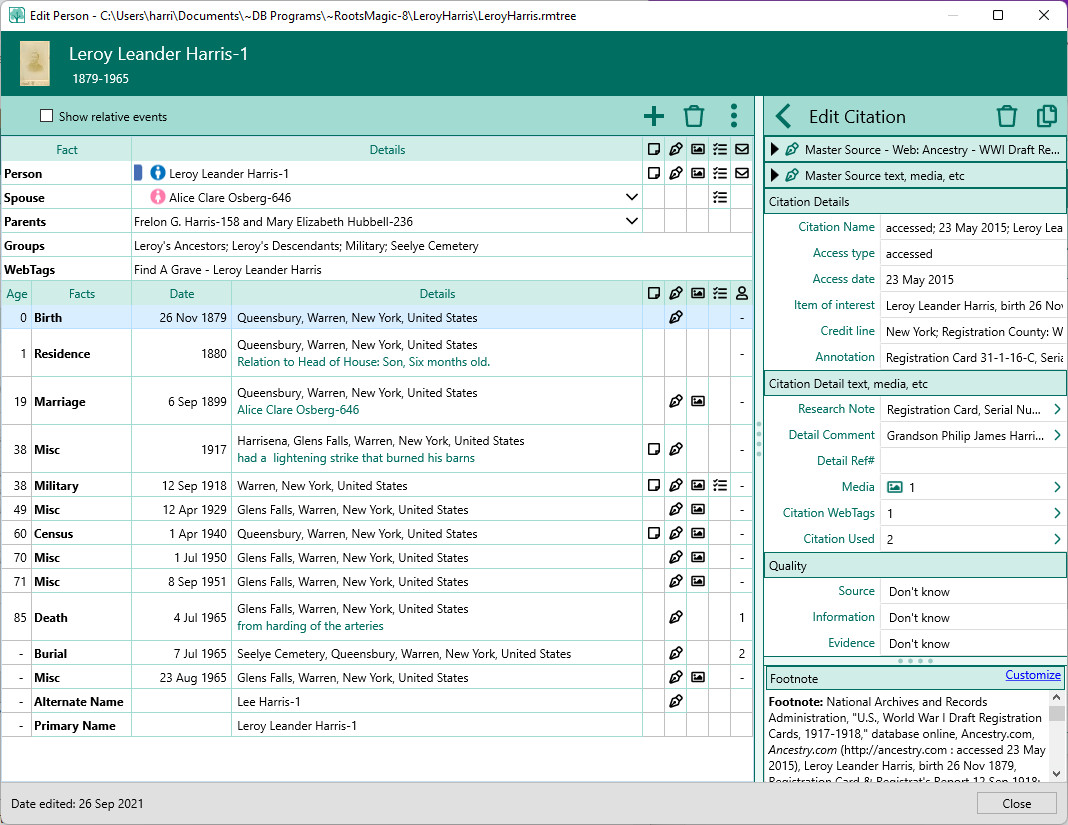Difference between revisions of "RootsMagic 8:Citation Quality"
| (6 intermediate revisions by 2 users not shown) | |||
| Line 1: | Line 1: | ||
| − | Navigation: [[RootsMagic_8:RootsMagic_8|RootsMagic 8]] > [[RootsMagic_8:Working_With_Sources|Working With Sources]] > | + | Navigation: <u>[[RootsMagic_8:RootsMagic_8|RootsMagic 8]]</u> > <u>[[RootsMagic_8:Working_With_Sources|Working With Sources]]</u> > |
---- | ---- | ||
| − | RootsMagic lets you apply a quality rating to each of your | + | RootsMagic lets you apply a quality rating to each use of your citations based on the industry-standard Elizabeth Shown Mills, "Process Map for Evidence Analysis", Evidence Explained: Citing History Sources from Artifacts to Cyberspace (Baltimore, Maryland: Genealogy Publishing, 2007). |
From her discussion, Sources give us information from which we select evidence for analysis. A sound conclusion may be considered Proof. | From her discussion, Sources give us information from which we select evidence for analysis. A sound conclusion may be considered Proof. | ||
| − | To enter your quality ratings | + | '''To enter your quality ratings''' |
| − | After careful analysis and evaluation of the associated source, you can enter a quality rating in each of | + | |
| + | After careful analysis and evaluation of the associated source, you can enter a quality rating in each of three factors that best describes the results of your analysis. | ||
| + | |||
| + | You will see the 3 Quality options when you are editing a citation on the edit person form. Just click each item and select the appropriate value from the drop list that appears. | ||
| + | |||
| + | [[File:RM8_EditPerson-Citation-1a.jpg|Citation 1]] | ||
| + | |||
| + | ===Source=== | ||
| + | *'''Original''' - This source is in its first recorded form | ||
| + | *'''Derivative''' - This source is extracted, transcribed or otherwise derived from the original | ||
| + | *'''Don't know''' | ||
| + | |||
| + | ===Information=== | ||
| + | *'''Primary''' - This information was provided by someone with firsthand knowledge of the person or fact | ||
| + | *'''Secondary''' - This information was provided by someone with secondhand knowledge of the person or fact | ||
| + | *'''Don't know''' | ||
| + | |||
| + | ===Evidence=== | ||
| + | *'''Direct''' - This source answers the research question by itself | ||
| + | *'''Indirect''' - This source is relevant, but needs additional information | ||
| + | *'''Negative''' - This source is missing information that it should contain | ||
| + | *'''Don't know''' | ||
| + | |||
| + | The quality is at the citation use level, since the same source (or even the same citation) can have a different quality depending on what it is used for. For example, a birth certificate could have a different quality depending on whether it was used for the person's birth, or used for the father's place of birth. | ||
Latest revision as of 22:40, 18 November 2021
Navigation: RootsMagic 8 > Working With Sources >
RootsMagic lets you apply a quality rating to each use of your citations based on the industry-standard Elizabeth Shown Mills, "Process Map for Evidence Analysis", Evidence Explained: Citing History Sources from Artifacts to Cyberspace (Baltimore, Maryland: Genealogy Publishing, 2007).
From her discussion, Sources give us information from which we select evidence for analysis. A sound conclusion may be considered Proof.
To enter your quality ratings
After careful analysis and evaluation of the associated source, you can enter a quality rating in each of three factors that best describes the results of your analysis.
You will see the 3 Quality options when you are editing a citation on the edit person form. Just click each item and select the appropriate value from the drop list that appears.
Source
- Original - This source is in its first recorded form
- Derivative - This source is extracted, transcribed or otherwise derived from the original
- Don't know
Information
- Primary - This information was provided by someone with firsthand knowledge of the person or fact
- Secondary - This information was provided by someone with secondhand knowledge of the person or fact
- Don't know
Evidence
- Direct - This source answers the research question by itself
- Indirect - This source is relevant, but needs additional information
- Negative - This source is missing information that it should contain
- Don't know
The quality is at the citation use level, since the same source (or even the same citation) can have a different quality depending on what it is used for. For example, a birth certificate could have a different quality depending on whether it was used for the person's birth, or used for the father's place of birth.
